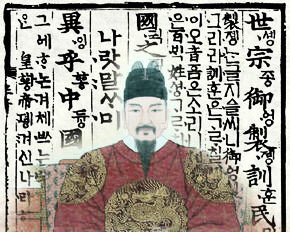hankyoreh
Links to other country sites 다른 나라 사이트 링크
Korean flag, gimchi head list of Korea's top symbols

Koreans think that the country's best symbols are the taegeukgi, South Korea's flag; gimchi; hangeul, the Korean writing system (and the book Hunmin Jeongeum, written in 1446 to explain its invention); the mugunghwa, or Rose of Sharon, the national flower, and the Dokdo islets, according to a Gallup Korea survey of 1,509 adults over the age of 20.
The survey, completed May and June this year, was commissioned at the request of the Ministry of Culture and Tourism.
Nearly 35 percent of respondents said the taegeukgi, the national flag, is the cultural symbol that represents Korea more than any other. Other symbols "most representative" of Korean culture - in addition to gimchi (22.1 percent), the hangeul writing system (17.2 percent), the Rose of Sharon (13.9 percent), and the Dokdo islets (13.2 percent) - were King Sejong (1397-1450), doenjang and cheonggukjang, or fermented soybean paste; Admiral Yi Sun-sin (1545-1698); traditional Korean clothing (hanbok), and the Palman Daejang Gyeong, a collection of Buddhist scriptures printed from 81,340 woodblock print plates kept at Haein Temple in South Gyeongsang province.

The taegeukgi also placed first in a vote on the Ministry of Culture and Tourism's web site during the months of February and March in which 1,437 people participated. Hangeul and gimchi also placed within the top five, just as in the Gallup poll.
Gallup also asked people what they would not like to see as representative of Korea. Ramyeon, or instant noodles, placed first with 28.4 percent, followed by gut, or shamanistic rituals (18.8 percent), the Korean "goblin" known as dokkebi (16 percent), the demilitarized zone (14.4 percent), gimbap (11 percent), and Samsin Halmae, the "spirit grandmother" who aids women in having children (8.8 percent).
The Red Devils, the official name for fans of the national football team, were found to be very controversial. They ranked 15th, or 5.3 percent, on the list of symbols best representing the country and 11th, or 4.9 percent, on the list of symbols people would most like to see excluded as a national symbol.
On Wednesday the Ministry of Culture and Tourism released an official list of 100 symbols of the Korean people. In addition to symbols frequently mentioned in public surveys, other interesting items included on the list were ondol, the heated floors of Korean homes; dolmens, or large ceremonial stones; mass cheering for sports events, and jajangmyeon, a dish developed by Chinese restaurants in Korea and not found in other countries. According to a ministry statement, the list was drafted after several public opinion surveys and lengthy consultations with scholars and experts over an approximately one-year period beginning in February 2005.
Editorial・opinion
![[Column] Has Korea, too, crossed the Rubicon on China? [Column] Has Korea, too, crossed the Rubicon on China?](https://flexible.img.hani.co.kr/flexible/normal/500/300/imgdb/original/2024/0419/9317135153409185.jpg) [Column] Has Korea, too, crossed the Rubicon on China?
[Column] Has Korea, too, crossed the Rubicon on China?![[Correspondent’s column] In Japan’s alliance with US, echoes of its past alliances with UK [Correspondent’s column] In Japan’s alliance with US, echoes of its past alliances with UK](https://flexible.img.hani.co.kr/flexible/normal/500/300/imgdb/original/2024/0419/2317135166563519.jpg) [Correspondent’s column] In Japan’s alliance with US, echoes of its past alliances with UK
[Correspondent’s column] In Japan’s alliance with US, echoes of its past alliances with UK- [Editorial] Does Yoon think the Korean public is wrong?
- [Editorial] As it bolsters its alliance with US, Japan must be accountable for past
- [Guest essay] Amending the Constitution is Yoon’s key to leaving office in public’s good graces
- [Editorial] 10 years on, lessons of Sewol tragedy must never be forgotten
- [Column] A death blow to Korea’s prosecutor politics
- [Correspondent’s column] The US and the end of Japanese pacifism
- [Guest essay] How Korea turned its trainee doctors into monsters
- [Guest essay] As someone who helped forge Seoul-Moscow ties, their status today troubles me
Most viewed articles
- 1[Column] The clock is ticking for Korea’s first lady
- 2[Correspondent’s column] In Japan’s alliance with US, echoes of its past alliances with UK
- 3Samsung barricades office as unionized workers strike for better conditions
- 4After 2 months of delayed, denied medical care, Koreans worry worst may be yet to come
- 5[Column] Has Korea, too, crossed the Rubicon on China?
- 6[Editorial] When the choice is kids or career, Korea will never overcome birth rate woes
- 7Hong Se-hwa, voice for tolerance whose memoir of exile touched a chord, dies at 76
- 8US overtakes China as Korea’s top export market, prompting trade sanction jitters
- 9Constitutional Court rules to disband left-wing Unified Progressive Party
- 10Nearly 1 in 5 N. Korean defectors say they regret coming to S. Korea